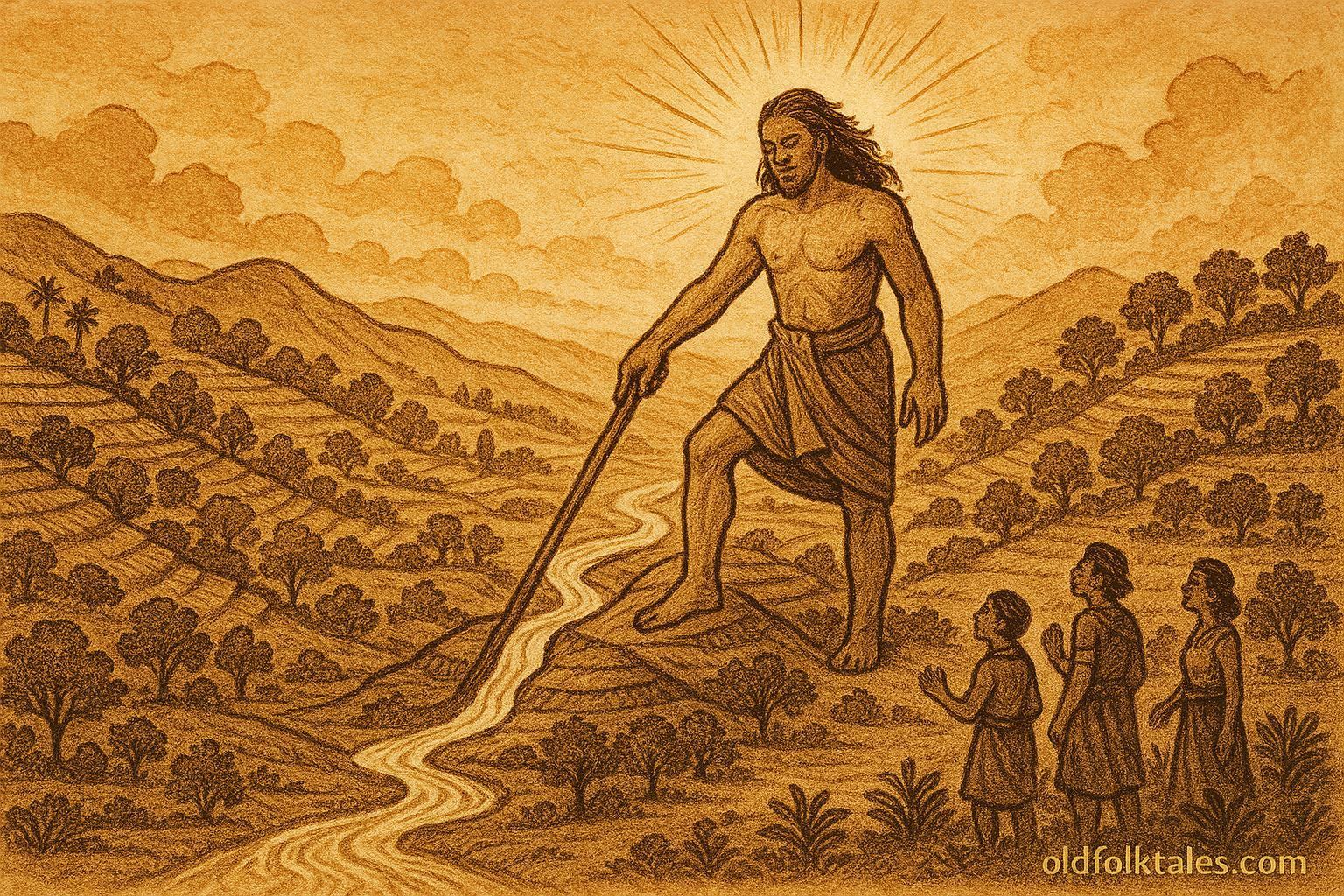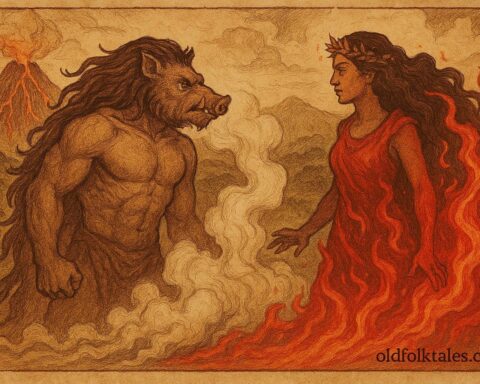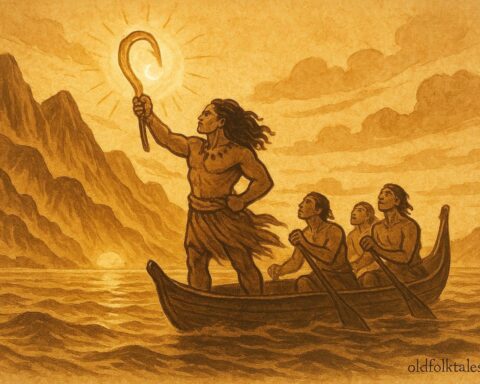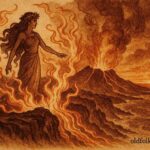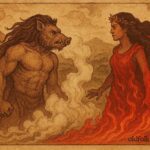In the time when the heavens were close to the sea and the gods still walked among mortals, there lived in the celestial realm of Tagaloa-lagi, the supreme creator, a radiant being named Pili. He was one of Tagaloa’s many sons, born of light and divine purpose. Among all his brothers, Pili was known for his curiosity, a spirit both humble and wise, always yearning to understand how life might flourish below, upon the still-unformed lands that floated between sky and sea.
Each day, Pili gazed down from the sky’s edge at the swirling blue world beneath. He saw only scattered islands rising like the backs of sleeping whales. The earth was barren, its soil unworked, its rivers dry. The people who dwelled there lived on what the sea offered, fish, shellfish, and seaweed, but they knew little of farming, building, or shaping the land.
Pili’s heart stirred with compassion. “Father,” he said to Tagaloa, “the people live close to the sea, but their lives are harsh. The earth beneath them sleeps. May I go down and teach them how to awaken it?”
Tagaloa, whose wisdom encompassed all realms, regarded his son for a long moment. “If you go,” he said, “you must not go as a god, but as a guide. The earth must learn to grow through human hands, not divine command.”
Pili bowed. “Then I shall be their teacher, not their ruler.”
And so, with Tagaloa’s blessing, Pili descended from the heavens.
The Descent from Heaven
The winds of the upper sky carried him, and beams of sunlight wove around him like golden ropes. When he landed upon the island that would become Samoa, the ground trembled gently, not in fear, but in welcome. The people saw him come down upon a high hill overlooking the sea. His hair shimmered like the dawn, and his eyes held the deep calm of the ocean depths.
The islanders gathered before him, astonished and uncertain. Their chief approached, kneeling low. “Who are you that the winds obey you?”
“I am Pili,” said the newcomer, his voice both gentle and commanding. “I am the son of Tagaloa-lagi, sent to help you shape the land, so that your children may never hunger.”
The people rejoiced, for they had long prayed for such help. Pili spent the first nights among them, listening to their songs, eating their food, and learning how they lived. He saw their struggles, how they dug at dry ground and found only stones, how their crops withered before they could grow.
“This earth must be taught to breathe,” he said at last. “Let us give it life.”
The Shaping of the Land
At dawn, Pili took up a great staff of wood, carved with signs of heaven and sea. He struck the ground three times, and from the earth burst forth the first rivers. They wound down the hillsides like silver serpents, bringing water to the valleys.
Then Pili lifted the soil in his hands and spread it across the flatlands. Where his fingers touched, the dirt turned rich and dark, ready for planting. He called to the people: “Now learn to sow.”
He showed them how to dig terraces into the hills, shaping them like great steps that climbed toward the sky. “These are the bones of the earth,” he said. “If you care for them, they will hold your crops and feed your children.”
Under his guidance, the Samoans planted taro, yam, and banana, the sacred foods of life. He taught them the rhythm of planting and harvest, how to speak to the land with respect, and how to give thanks after each season.
The island began to change. Green fields spread across the valleys, water sparkled through the plains, and villages rose where once there had been only scattered huts.
Pili smiled to see the people laugh and sing while they worked. “This,” he said softly, “is the harmony my father wished for the world.”
The Lessons of Harmony
But Pili’s work did not end with the earth. He saw that where people gathered, so too came envy and quarrel. Some wished for more land, some hoarded their harvest. So Pili gathered the chiefs together and spoke to them beneath the shade of a great breadfruit tree.
“The land is alive,” he said. “When you share its gifts, it smiles upon you. But when you take more than you need, it withers. You must care for it as you would care for a child, with patience and fairness.”
He taught them laws of stewardship, how to mark the boundaries of gardens with stone and shell, and how to plant trees so that each generation would inherit shade and fruit. He gave them the proverb that Samoans still cherish:
“E le sili le ta‘i i lo le tapu‘ai”, “The worker is not greater than the prayer.”
For Pili taught that labor must walk hand in hand with gratitude, and that every harvest should begin and end with offerings to Tagaloa.
The Parting of the Earth Shaper
Years passed, and the people of Samoa grew wise and prosperous. Their terraces climbed the mountains, their rivers sang through the valleys, and their hearts were bound in peace. Pili, though still strong, felt his time among mortals drawing to an end.
One evening, as the setting sun turned the sky to fire, he climbed the same hill where he had first descended. The people followed him, weeping, for they knew he was leaving them.
“Do not grieve,” he told them. “I will not be far. Every field you plant, every stream that flows, bears my touch. When you till the soil and sing to the land, I will hear you. When you look upon the terraces and see them glow at sunrise, know that I am still shaping them through your hands.”
Then the clouds parted, and a great beam of light reached down from the heavens. Pili stepped into it, and the winds carried him upward until he vanished among the stars.
But the people of Samoa did not forget. They built a stone platform on the hill where he had stood and called it Mauga o Pili, the “Mountain of Pili.” There, they offered gifts of food and flowers to honor the Earth Shaper who had given them the knowledge of cultivation and the grace of civilization.
And to this day, when Samoan farmers bless their fields, they whisper his name, Pili, son of Tagaloa, in gratitude and remembrance.
Moral Lesson
The story of Pili, the Earth Shaper speaks of divine stewardship, balance, and the responsibility of humankind to care for the land. It reminds us that wisdom is not only learned from the gods but sustained through human effort and humility.
Knowledge Check (Q&A)
1. Who was Pili, and what was his divine origin?
Pili was the son of Tagaloa, the Samoan god of creation, sent to shape the land and teach humanity how to live in harmony with nature.
2. What cultural lesson does this Samoan folktale teach?
The story emphasizes stewardship of the earth, divine guidance, and the importance of gratitude and cooperation within a community.
3. What did Pili create to help the people?
He formed rivers, terraces, and fertile lands, teaching the Samoans how to plant taro and build organized villages.
4. What is the symbolic meaning of Pili’s spirit remaining in the land?
It represents the belief that divine guidance continues to live within nature and that ancestral wisdom remains part of the land itself.
Source: Adapted from Legends of the South Seas by A.W. Mackay (1899)
Cultural Origin: Samoa (Polynesia)
